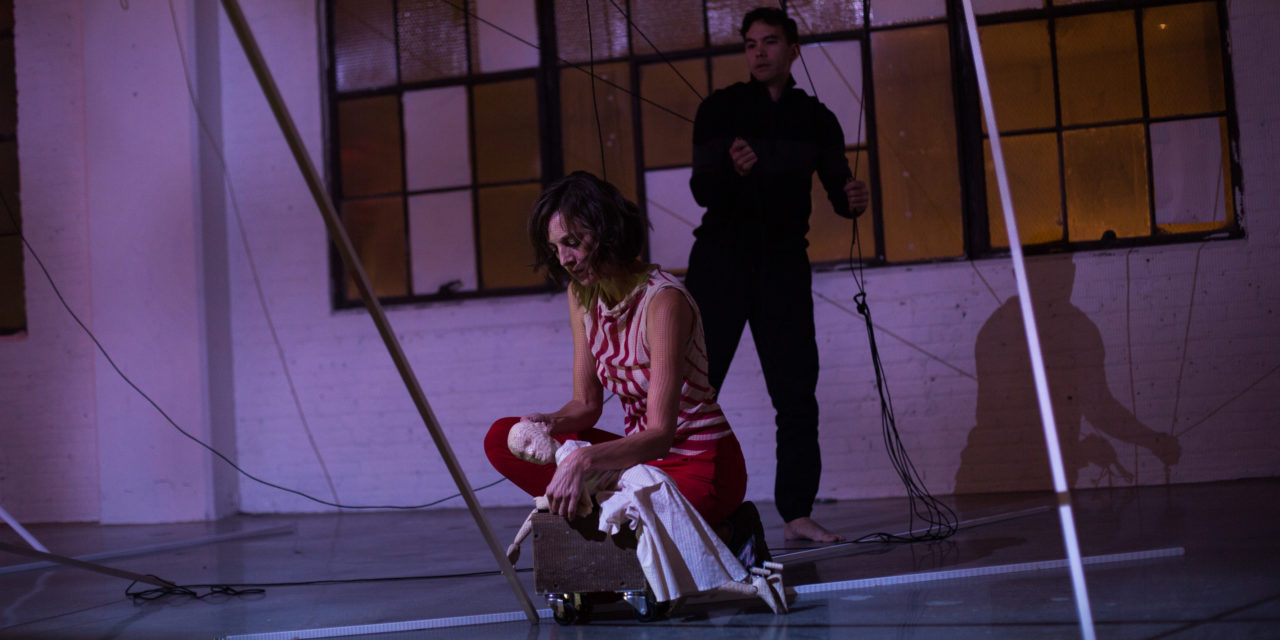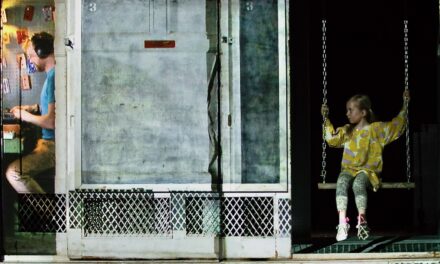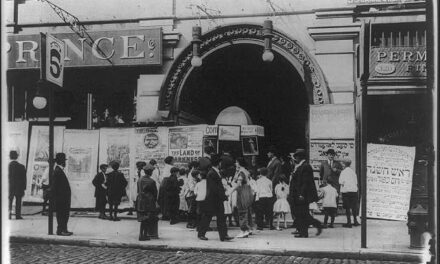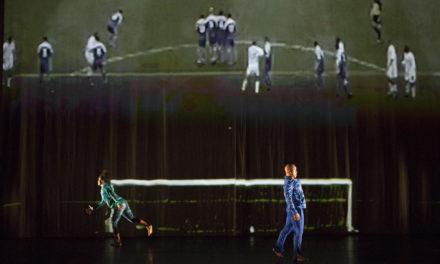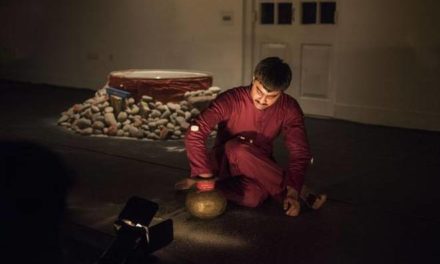Dixon Place is known for their commitment to supporting the creative process as well as hosting new works series, and Puppet BloK is no different. In 2006, curator Leslie Strongwater began Puppet BloK, a works-in-progress series of groundbreaking new works of puppetry and other innovative forms of storytelling.
There are several puppetry showcases scattering the greater New York City area, but what sets Puppet BloK apart is that the series is carefully curated by CB Goodman, an artist that specializes in devising theatre that incorporates disparate materials and object manipulation, blurring the lines between truth, lies, and theatricality.
CB is one of four 2017 Artists in Residence at Dixon Place. Her goal in curating Puppet BloK is to meet puppeteers, provide artists with more opportunities, and to give back to Dixon, as it is the first place that gave her an artistic home.
On October 3rd, Puppet BloK will begin transforming Dixon’s 36 x 20 black box theater into a “space to dream.”
“Puppets can do things that transcend what human beings can. A puppet can be 10 feet tall or 1 inch tall. It creates distance, a distance which makes the content more accessible.” – CB Goodman
According to CB, the most exciting part of this program is that, “each night will be completely different. Puppet BloK creates a community for artists and audience members to promote conversation outside of Dixon’s walls. Artists and audiences alike are given the opportunity to explore what puppetry can be and challenge themselves to become immersed in new puppetry practices.”
This year at Puppet BloK
This year’s Puppet BloK features an impressive line-up of artists showcasing their work, resulting in a 35 artist workshop spanning over a 9 day period.
Some of this years’ artists include:
Charlotte Durkee – A Lesson in Being Smothered By A Dragon
Charlotte Durkee is a performer, director, and designer from New York, NY. Her work is guided by the melding of the hand-made and digital crafts. She is about to start her last year of the undergraduate program at the New School for Drama where she will be getting a BFA with a minor in creative technologies. Some of her previous work includes video design on a 360 video/theatrical experience of Beckett’s Waiting for Godot, projection, and sound for the play adaptation of Georg Büchner’s Lenz, and featured sound design on Dan Hurlin’s Demolishing Everything With Amazing Speed.
A Lesson in Being Smothered By A Dragon is about Addie.
Addie is not happy.
Addie works at a home movie theater in the city.
Addie has a foreboding feeling that a dragon is coming to smother them.
Indeed, there is a dragon ready to smother Addie and there is seemingly nothing to be done.
A Lesson In Being Smothered By A Dragon is a short play about our sometimes keen ability to allow ourselves to be smothered by our own personal dragons.
Q: What is your relationship to puppetry?
A: My relationship to puppetry began when I started making stop-motion animations as a kid. I would love to make these music videos for outsider music tunes where I would create these worlds out of paper and I would tell the stories with little paper dolls I made. They’re on youtube somewhere and they’re pretty primitive but that was the start of things. It wasn’t until later that a teacher told me “oh yeah you’re a puppeteer” that got me started on an even further obsession with creating these magical hand-crafted digital worlds with puppets.
Q: Why did you choose to showcase your work at Puppet BloK?
A: Well, I didn’t know about Puppet BloK until I was contacted by C.B. Goodman asking if I had anything that I wanted to share, but I chose to brave up and join the festival because I figured when else would I get this invitation as a young artist to showcase my work to a public audience? And I’m so happy that I braved up.
Q: What do you value most about this opportunity?
A: I really value this opportunity to showcase A Lesson In Being Smothered By A Dragon because at this point in my life I could have easily passed on it out of feeling like I wasn’t ready but I’m so lucky to have been given the space to be bold and showcase some original work. To a young artist in a city where performance and rehearsal spaces are hard and expensive to come by it means so much. It is such a privilege to be given the physical and emotional space to grow, plus I get to do it alongside other artists I greatly admire, I just feel really grateful.
Q: How do you see your work progressing from here?
A: I have been so inspired by the community of artists I’ve met so far and the beautiful artists that I have worked with in creating this short show. Just one of those beautiful artists I got to work with on A Lesson In Being Smothered By A Dragon is our crazy talented scriptwriter Lilith Bachelder who taught me that it’s no fun to work isolated and with a bunch of weight on your shoulders. It’s such a joy to get to work with and learn from people you respect, all I ask from my future is that I’m able to continue being in awe of the people around me and that my work can reflect that.
Shayna Strype – Antrak
Shayna Strype is a theater-maker based in Brooklyn. Most recently, she has worked with David Neumann (Tough, The Tough: Redux), Trusty Sidekick Theater Company (We Are All Tourists) and The Civilians (The End And The Beginning, The Way They Live). Shayna received her MFA from Sarah Lawrence College and currently teaches theater at Friends Seminary.
When chaos strikes the colony, a lost ant resorts to traveling cross-country by Antrak train. This Studs-Terkel-Wannabe journeys into the unknown, buoyed by the grandeur of American landscapes, the fleeting intimacy of conversations with strangers, and a deep desire to understand what is going on beyond its own colony. Shayna Strype constructs this story through manipulated cardboard objects, toy theater puppetry, live feed projection, and footage from interviews she recently conducted with Amtrak passengers across the US.
Q: What is your relationship to puppetry?
A: When I was a kid, I went to a puppet camp (by accident) and was terrified by the entire endeavor. I begged my parents to never send me back. Years later, however, after studying experimental and devised theater, I’ve come to love puppetry as the expansive, multi-dimensional art form that it is. In my work, I’ve found that the inherent playfulness of puppetry allows for an exploration of material that can be challenging or socially-minded without feeling too heavy-handed and didactic. Most of the theater I make tends to have some puppetry-element in it, whether it be object-manipulation, toy-theater, live feed, stop-motion animation, or wearable sculpture.
Q: Why did you choose to showcase your work at Puppet BloK?
A: Puppet BloK champions theatrical experiments and serves as a supported space to present new ideas. It’s a great opportunity to get feedback from both audience members and other participants in the festival.
Q: What do you value most about this opportunity?
A: I deeply value Puppet BloK’s support of artists at different points in their process and how not every piece in the festival is a polished, final product. The opportunity to show works-in-progress is crucial for the development of new work. Many artists and I myself count on Dixon Place and the Puppet BloK festival as a place to experiment, take risks, and make things that could potentially fail in big, fun, messy ways. I also value the community of creative artists that have been brought together through this opportunity.
Q: How do you see your work progressing from here?
A: I am currently a resident at the Object Movement festival where we meet weekly and workshop our pieces. I hope to take what I learn from performing my piece at Puppet BloK and integrate my findings into a new, longer version of the show that I will present in the Spring at the Object Movement Festival.
Catherine M. Chin – As Fast Or Faster
Catherine M. Chin is an interdisciplinary writer, artist, and scholar based in northern California and in Michigan. Originally a historian by profession, she has begun work in puppetry, working for Obie and Bessie award-winning theatre artist Dan Hurlin, and studying with Vermont-based puppet artist Eric Bass as well as puppet artist and projection designer Tom Lee.
A crack in a wall is energy finding the fastest way out. Cracks and fractures run, explore, and escape; they find new places, struggle with outside forces, and turn the places they have left into new objects. Using both manual and digital means of live manipulation in tandem, the artists breathe life into shadows and fissures to make As Fast Or Faster, a short visual poem about cracks in the material world and about the forces that become visible when the world is under stress.
Q: What is your relationship to puppetry?
A: My first impulse is to say, “abject fear,” but that’s not exactly right. I’m fairly new to puppetry and I’m coming to it from being mostly a writer and a historian. But over the last few years I’ve realized that objects and puppets are a much more powerful medium than words for some of the ideas I’ve been exploring, which are, generally, ideas about what is solid and what’s not, and why that’s surprising sometimes; what is alive and has desires and what’s not, and how we can tell which is which. Right now, objects and puppets teach me more than words do. They also teach me very different things than words can. So maybe “abject fear and fascination and experimentation and inarticulate fun and unfolding-unfolding-unfolding things about the world, all mixed together” is a better answer. Puppets are incredible teachers. And I’ve always been a little scared to let my teachers down.
Q: Why did you choose to showcase your work at Puppet BloK, and what do you value most about this opportunity?
A: It’s a great opportunity to be part of a series that I admire intensely, as well as to work alongside, and to see work by, artists whom I also really admire, and whom I’ve already learned so much from. To me, this is less about showcasing my own work and more about being able to be part of a much bigger group of artists who do remarkable things that I would never even think of myself. How could I say no to that? I’m not even sure I could say it was a conscious choice on my part to do it: the moment when I realized that I had the chance to put some work into that mix, my body spontaneously curled into a fetal position and broke out into a cold sweat. Which was how I knew it was obviously the right thing to do. On a practical level, although I’m not based in New York, my brilliant and amazing collaborators (Lucas Wilson-Spiro and Elle) are, and this seemed like a great chance to work with them more closely—they are among the folks I’ve learned the most from.
Q: How do you see your work progressing from here?
A: Well. I’m not sure exactly how to say this. For the next stage of this work, what I see is–I see millions of tiny green grasses everywhere that are trying to eat the sun…I think I’ll just leave it at that.
Sachiyo Takahashi – Sheep #1
Sachiyo Takahashi is an artist, composer, and performer whose work centers around storytelling. Compositing sensory elements in a minimalist manner, she explores the border between narrative and abstraction to generate fables for the subconscious. Sachiyo founded Nekaa Lab in 2006 together with other “lab members” (stuffed toys and tiny figurines). She has been producing performances, installations, and writings while observing human nature from alternative perspectives. She is a recipient of The Jim Henson Foundation grant 2017, and currently developing her new piece Everything Starts From A Dot, which will premiere in Fall 2018. Sachiyo lives and works in Brooklyn.
Sheep #1 is a mesmerizing, minimalist story told through live projection and live music.
Q: What is your relationship to puppetry?
A: I have been creating fables around emotions and the senses, which explore the border between narrative and abstraction, audio and visual, and the use of non-human figures. These intersects have been my interests throughout my career. I believe in the potential of indirect expression through objects and how it could expand our imagination. I think these are the essential features of puppetry.
Q: Why did you choose to showcase your work at Puppet BloK?
A: I have been exploring puppetry since a 2006 live projection performance platform that I call Microscopic Live Cinema-Theatre. For the first time, I am incorporating live music to this platform in Sheep #1. I want to try out these new elements in front of an audience. Puppet BloK is the perfect and rare opportunity for this.
Q: What do you value most about this opportunity?
A: Meeting the audiences as well as people of the puppetry community and getting feedback from them while presenting a work-in-progress work.
Q: How do you see your work progressing from here?
A: I am planning to present the complete version of Sheep #1 in Spring 2018.
Puppet BloK is at Dixon Place from October 3 to October 25.
This series is supported in part with generous funding from the Jim Henson Foundation.
Dixon’s mission: An artistic incubator since 1986, Dixon Place is a Bessie and Obie Award-winning non-profit institution committed to supporting the creative process by presenting original works of theater, dance, music, puppetry, circus arts, literature & visual art at all stages of development. Presenting over 1000 creators a year, this local haven inspires & encourages diverse artists of all stripes & callings to take risks, generate new ideas & consummate new practices. The artist’s experience is given top priority through Dixon’s professional atmosphere and remuneration, and their process is enhanced through the reaction of their adventurous audiences. Dixon Place is a local haven for creativity as well as an international model for the open exploration of the process of creation.
This post was written by the author in their personal capacity.The opinions expressed in this article are the author’s own and do not reflect the view of The Theatre Times, their staff or collaborators.
This post was written by Krista Jarboe.
The views expressed here belong to the author and do not necessarily reflect our views and opinions.

